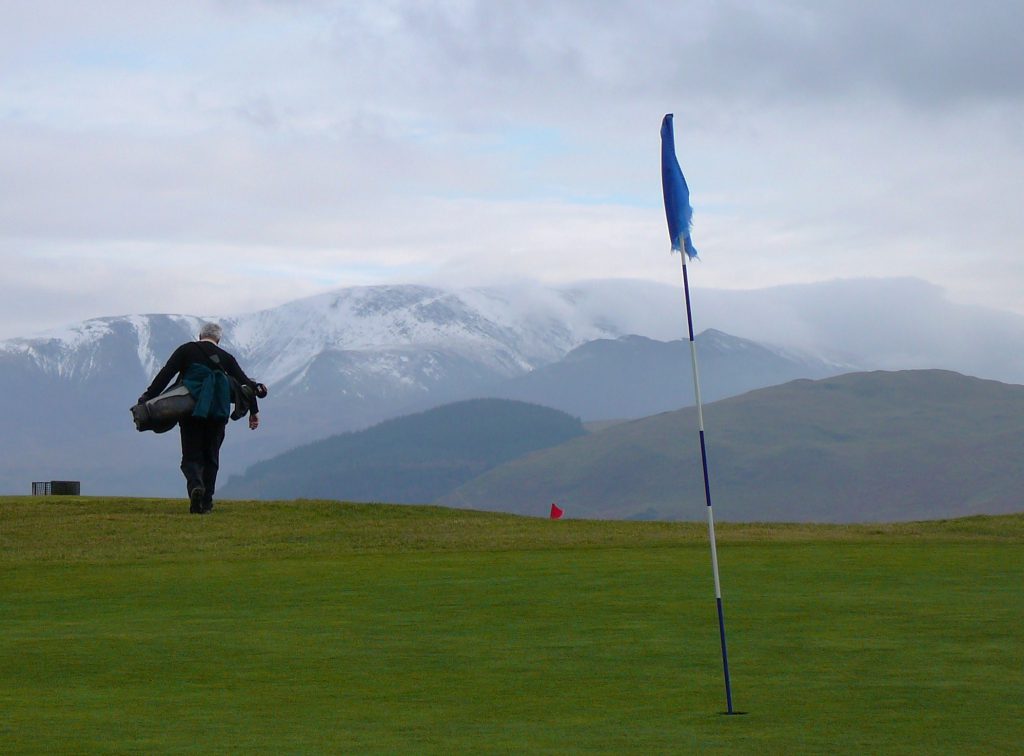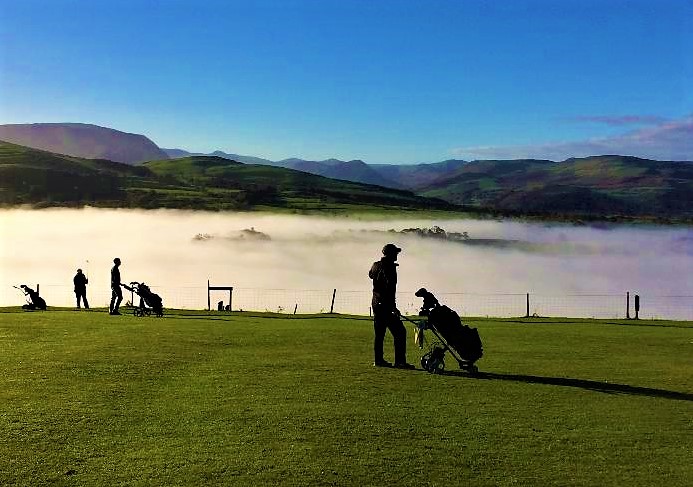

Cockermouth Golf Club is situated 3 miles east of Cockermouth. You are surrounded by excellent views including Skiddaw, the Lorton Fells, Scotland and even, weather permitting, the Isle of Man.
James Braid (6 February 1870 – 27 November 1950) was a member of the Great Triumvirate alongside Harry Vardon and John Henry Taylor. He won The Open Championship five times. He was also a renowned golf course architect. Cockermouth Golf Course is among his designs along with the likes of the “King’s Course” and the “Queen’s Course” at Gleneagles, and the 1926 remodelling of Carnoustie Golf Links for The Open Championship that year.
Braid set the standard in golf course design that the rest of the world would follow. He was a pioneer in his field and his legacy lives on in over 200 courses across Scotland and the UK. To fully understand why James Braid is considered one of the finest golf course designers of all time, you simply have to see his work for yourself.

Course Highlights
The 8th is one of the best par 4’s in Cumbria and the 10th is an impressive signature hole which tests your confidence in your driving with a 180 yard tee shot reaching the dogleg-esque fairway but only if hit straight – veer left and its a several hundred yard drop off a cliff. Alternatively you can effectively lay up from the get go with a shorter club and look simply to reach the front of the fairway which is 119 yards away & negates most (if not all) of the risk of the ball literally falling off a cliff. This one tee shot at the 10th neatly sums up the course’s design – one that is based on precision over power with high risk opportunities to back the use of measured power. This design also makes the course very playable and a test for all levels of playing ability.
Playing the Course
The 6th, 7th & 8th holes are 3 of the 4 hardest holes back to back to back & this stretch of the course can make or break a round. This is followed by the two easiest holes on the course – the par 3 9th & the short par 4 10th. If you can navigate these five holes at par (or better) you could be heading for a decent score. The 11th; 12th & 13th are generally better respected than attacked although the 478 yard par 5 12th is an opportunity to make some inroads for longer hitters. The fairway does narrow into a bottleneck between 280 & 310 yards from the white tees.
1
This hole requires a teeshot aligned left that fades back in so as to avoid the path of the grass bunker protecting the green or, for those more confident off the tee, a reachable green & eagle opportunity – using either the driver or 3 wood.
2
The most reachable fairway is the 2nd – 128 yards reaches it from the white tees & the initial portion is 37 yards across. It takes a 247 yard drive to reach the front of the green making it an eagle opportunity for average-long drivers who are confident with the putter.
3
The par 4 3rd hole balances the difficulty of playing to a steep uphill direction with the relative forgiveness of the widest fairway on the course (excluding par 3’s) – as wide as 40 yards.
4
The 4th is a relatively (within the context of the course) long par 3 – rewarding accurate middle iron play off the tee. This par three presents a blind teeshot marginally down onto a short but wideish fairway which starts 112 yards from the white tees & measures 56 yards (in length) by 47 yards at its widest point. Plays a club or so shorter than its nominal 182 yard length considering the elevated tee position. A 5, 6, 7 or even 8 iron will suffice off the tee for most players. A right aligned draw shape shot is suggested. Considering the change in elevation and blind tee shot a 3 here should be considered a win in most cases.
5
The par 4 5th requires 106 yards to reach the fairway off the white tees. The fairway peaks at 47 yards at its widest point & 29 yards at its narrowest. A teeshot of 166 yards is required to reach the peak of a hill ensuring your approach shot onto the green is not a blind one; although if you manage this you are likely to roll down the back of the hill into wedge territory for your second shot. A 3 wood or even 5 wood/driving iron is suggested for longer hitters as drives of 283 yards (total) are penalized by a grass verge that protects the area in front of the green.
6
The tee shot is easily missed to the right of the fairway as the pivotal 3 hole stretch starts. A 3 wood (or even long iron) is the prudent club of choice off the tee considering the 352 yards required to reach the green (unless you’re joining us from the World Long Drive Championship) – followed by a mid-iron of your choice onto a green which measures 23 yards deep.

7
The 7th plays 392 yards off the white tees with 124 yards required to reach the front edge of the fairway. Driver followed by 7/8/9 iron is the most common path to getting on in two. This section of the course is particularly open to windy conditions if present.
8
The fairway is 140 yards from the white tees. Medium-long hitters with the long stick will be aiming at a target as narrow as 17 yards across at 267 yards. The conservative play is a 227 yard teeshot with a 3 wood to a wider (26 yards across) portion of the fairway. This leaves you with a mid to long iron uphill approach of around 195 yards onto the elevated green. Alternatively if you are a longer hitter and a confident one at that (who hits it 300 yards off the tee more often than not) the shot shape most likely to give you a chance of getting on in two is a slight draw.
9
The par 3 9th hole is target golf time with a lofted iron or even wedge for longer hitters. The green slopes down from right to left from the tee box and a miss right gives you a better chance of at worst a two putt finish than a miss left (dependant on hole location).
10
The fairway starts 127 yards from the white tees and a right aligned, draw shaped tee shot is favoured allowing for the ball to potentially trickle down to within 40 yards of the front of the green by taking advantage of the down slope.
11
The 11th gentle dogleg par 4 calls for a driver plus wedge for most with a fade shape shot preferable from the tee.
12
The courses’ only par 5 is a chance for mid to longer hitters to cash in with the green reachable in 2 for many provided keep it straight down what at its narrowest point is a 20 yard wide fairway. The second shot feeds into a downhill portion which will yet further help reaching the green or thereabouts in two. Alternatively shorter hitters should comfortably be able to reach the green in three with a 3 wood; long iron followed by a mid iron or wedge.
13
The 13th is a hole that has caught out even professional golfers on occassion & should be treated with due deference. A fairway wood or even iron off the tee here allows for an approach shot with a mid iron into the green and a fair chance of taking a good par away from this hole. A slight draw shape to your tee shot opens a clear path to the green for your approach.
14
The 14th is a classical gentle dogleg par 4 covering just 282 yards which feels more like 320 yards given the upward slant of the fairway and the elevated green. A 3 wood draw shaped tee shot followed by a wedge into the green offer a chance to convert accurate approach play into a birdie if executed well.
15
A 185 yard par 3 calls for a mid iron tee shot to a relatively generously sized green. This is a pin that can be attacked as even errant tee shots generally allow plenty of opportunities to get up and down and salvage par.
16
What goes up… the 16th is a downhill drive onto one of the hardest fairways to reach on the entire course. A 339 yard par 4 might sound like the place to attack but the combination of the step downhill from tee to green & the high fraut with danger teeshot – most will be well advised to take out a 3 wood or even long iron.
17
A 158 yard par 3 from an elevated tee onto a good sized green calls for a mid iron or higher – imparting plenty of height and backspin onto the tee shot will see it stand a great chance of finishing on the green.
18
The 18th requires 117 yards off the white tee to reach the fairway & a fade shaped long iron will generally suffice for those aiming to get on in two & unless your surname happens to be McIlroy or Johnson it probably should be given the 307 yards required to reach the front of the green from the white tees with driver (blind).









